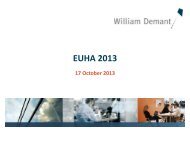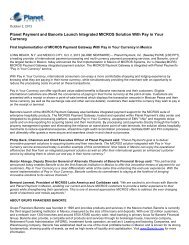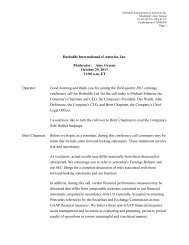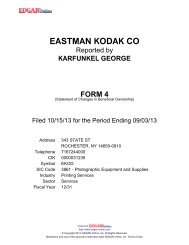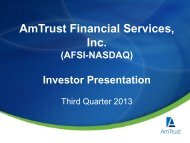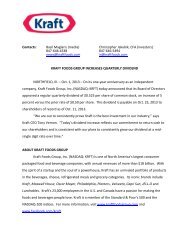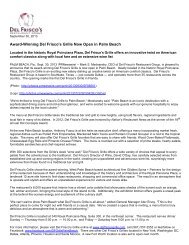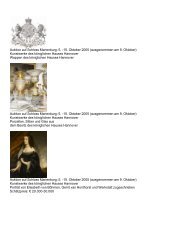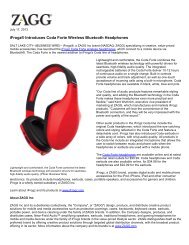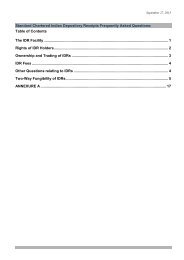Hypercom Corporation Annual Report - CiteSeer
Hypercom Corporation Annual Report - CiteSeer
Hypercom Corporation Annual Report - CiteSeer
Create successful ePaper yourself
Turn your PDF publications into a flip-book with our unique Google optimized e-Paper software.
1. Description of Business<br />
HYPERCOM CORPORATION<br />
NOTES TO CONSOLIDATED FINANCIAL STATEMENTS<br />
DECEMBER 31, 2009<br />
<strong>Hypercom</strong> <strong>Corporation</strong> (“<strong>Hypercom</strong>”) is one of the largest global providers of complete electronic payment and transaction<br />
solutions and value-added services at the point-of-transaction. <strong>Hypercom</strong> designs and sells electronic transaction terminals, peripheral<br />
devices, transaction networking devices, transaction management systems, application software, and information delivery services.<br />
Additionally, <strong>Hypercom</strong> provides directly, or through qualified contractors, support and related services that complement and enhance<br />
its hardware and software products. <strong>Hypercom</strong>’s customers include large domestic and international financial institutions, electronic<br />
payment processors, large retailers, independent sales organizations (“ISOs”) and distributors as well as companies in the<br />
transportation, healthcare, pre-paid card and quick service restaurant (“QSR”) industries. <strong>Hypercom</strong> operates in one business market—<br />
electronic payment products and services.<br />
<strong>Hypercom</strong> is headquartered in Scottsdale, Arizona, where its operations include corporate administration, product development,<br />
sales and marketing, distribution, repairs management and customer service. <strong>Hypercom</strong> has sales and support offices in Australia,<br />
Brazil, Belgium, Chile, China, France, Germany, Hong Kong, Hungary, Latvia, Mexico, the Philippines, Puerto Rico, Russia,<br />
Scotland, Singapore, Spain, Sweden, Thailand, the United Arab Emirates and the United Kingdom (“U.K.”). These sales and support<br />
offices perform sales, marketing, distribution, customer service and custom development functions. <strong>Hypercom</strong>’s primary<br />
manufacturing is performed by third party contract manufacturing operations located in Malaysia, Germany, Brazil, Romania, and<br />
Tunisia. <strong>Hypercom</strong> has global product development facilities primarily in the U.S., Germany, France, Philippines and Latvia.<br />
2. Significant Accounting Policies<br />
Principles of Consolidation<br />
The consolidated financial statements include the accounts of <strong>Hypercom</strong> and its wholly-owned subsidiaries (collectively, the<br />
“Company” or “<strong>Hypercom</strong>”). The Company, directly or indirectly, owns 100% of the outstanding stock of all of its subsidiaries with<br />
the exception of one subsidiary in Thailand. The Company owns a controlling interest in the Thailand subsidiary and certain nominee<br />
shareholders own the remaining nominal shares. All of the Company’s subsidiaries are included in the consolidated financial<br />
statements, and all significant intercompany accounts and transactions have been eliminated in consolidation.<br />
Use of Estimates<br />
The preparation of the consolidated financial statements in conformity with U.S. generally accepted accounting principles<br />
requires management to make numerous estimates and assumptions that affect the accounting, recognition and disclosure of assets,<br />
liabilities, stockholders’ equity, revenue and expenses. The accounting estimates that require management’s most significant, difficult<br />
and subjective judgments include collectability of accounts receivable; determination of inventory obsolescence; recoverability of<br />
long-lived assets and goodwill; expected product warranty costs; recognition and measurement of current and deferred income tax<br />
assets and liabilities; legal and tax contingency accruals; the recognition and measurement of contingent liabilities to the Company’s<br />
third-party contract manufacturers, for component parts that the Company may not ultimately use, and restructuring reserves. The<br />
actual results experienced by the Company may differ from management’s estimates.<br />
Cash and Cash Equivalents<br />
The Company considers all financial instruments, including money market accounts and certificates of deposits, with a<br />
remaining maturity of three months or less when purchased, to be cash equivalents.<br />
Fair Value of Financial Instruments<br />
The carrying amounts of cash and cash equivalents approximate fair value due to the short maturity of those instruments. The<br />
fair value of marketable securities is determined based on quoted market prices, which approximate fair value. The fair value of salestype<br />
leases and long-term obligations is estimated by discounting the future cash flows required under the terms of each respective<br />
lease or debt agreement by current market rates for the same or similar issues of leases or debt with similar remaining maturities. The<br />
fair value of financial hedge instruments are based on quotes from brokers using market prices for those or similar instruments.<br />
- 54 -



